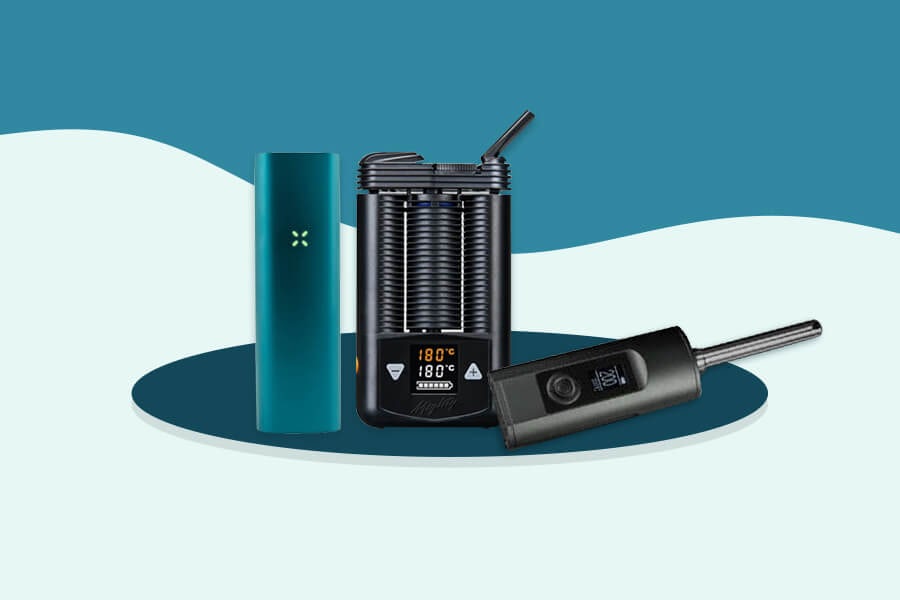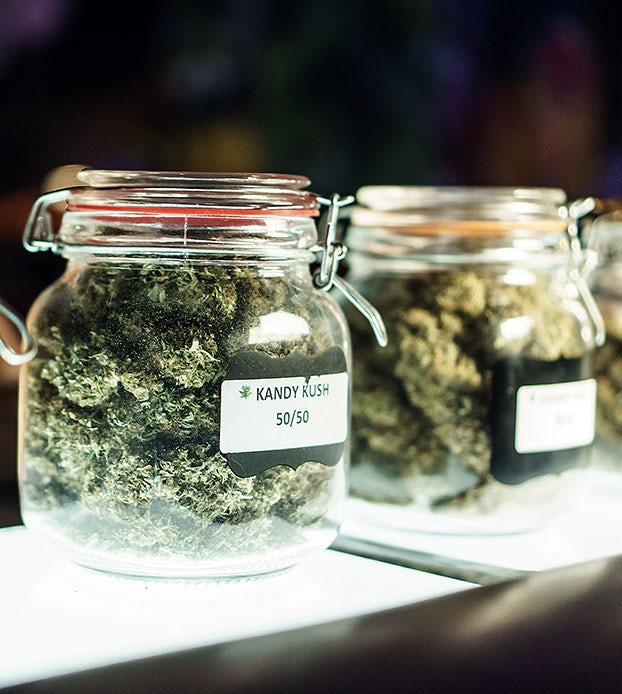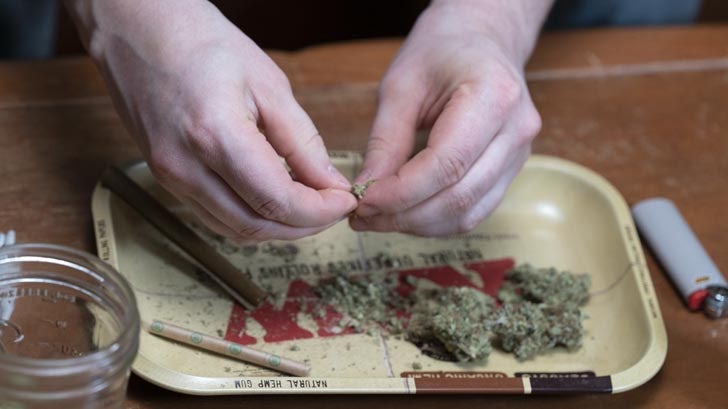Vaping is an increasingly popular way to consume cannabis. Yet, there’s a lot to know if you want to vape weed properly. You should be aware of the health risks, different types of vape products, and tips on how to vape correctly.
Vaping vs. smoking marijuana
Vaping is a popular alternative to smoking marijuana. Although both methods involve inhaling cannabinoids, vaping greatly reduces the amount of the toxic compounds produced by combusting cannabis, making it a safer option. 1
Another advantage of vaping is that you’re not limited to cannabis flower and can use waxes, oils, distillates, and other extracts.
A 2018 study on infrequent cannabis users found that vaping cannabis (containing 10 mg or 25 mg THC) produced stronger effects and higher blood THC levels when compared to smoking. 2
According to the researchers, “vaporizers appear to be a more efficient cannabis and THC delivery method, likely because with traditional smoked preparations, more THC is lost as a result of pyrolysis (combustion) and/or sidestream smoke.”
How to use a weed vaporizer
The precise steps will depend on the kind of device you’re using, but here’s a rough guide on how to use a cannabis vape:
1. Grind the cannabis

If using dry flower, grind it and place it into the chamber. Otherwise, attach your THC oil cartridge to your battery or add your concentrate to the chamber.
2. Turn on the vaporizer

If you can change the voltage, start with the lowest setting. If your device has an adjustable temperature, start with around 315-320°F (157-160°C).
3. Inhale

Press the button or inhale directly for draw-activated devices. Start with a small puff, inhaling into your lungs or first into your mouth and then the lungs. Hold for several seconds and exhale.
4. Adjust to your needs

If the vape isn’t producing much vapor, try increasing the voltage or temperature. If it’s too harsh or too much vapor, ensure the vape is on it’s lowest setting and/or take a smaller puff.
Here are seven top tips for making sure you get the most out of your vaping experience:
1. Choose the right device
For starters, you should choose the right vape for your needs. Generally speaking, you’ll come across three main types of cannabis vapes:
- dry herb vaporizers
- oil pens
- dab pens
Dry herb devices vaporize cannabis flower, making them the closest experience to smoking cannabis. They maximize the whole-plant entourage effect and provide the full terpene flavor profile of cannabis.
But they also require more setup. You’ll need to grind the cannabis evenly and pack the chamber tightly while still leaving room for airflow. To get the best taste and richest vapor, it’s best to use fresh flower that’s neither too moist nor too dry.
Oil pens use a replaceable or refillable cartridge filled with THC distillate oil. They’re easier to use and more compact, making them a better on-the-go option.
But oil pens are not as cost-effective in the long run. There’s also a higher risk of getting a low-quality, potentially unsafe product.
Besides, most pens are made with distillate, which doesn’t provide the full range of cannabinoids and terpenes. The only exception is pens containing live resin, which is considered a more full-spectrum extract.
Dab pens, which are often also called wax pens, are used to vaporize cannabis concentrates of all types. Importantly, the process of dabbing is a specific type of vaporization known as flash vaporization, which requires higher temperatures compared to traditional vaping. As such, dab pens typically have higher temperature settings than dry herb vapes or oil pens. Dab pens tend to have the strongest effects because of high THC concentrations found in cannabis extracts; even a very small dab can deliver a large dose of cannabinoids and terpenes.3
2. Consider voltage and temperature
You should start with the lowest available power or voltage setting before trying higher ones. Of course, this is not a very precise way to predict temperature, but with many vape pens these settings are as precise as it gets.
If your device has adjustable temperatures, as is often the case with dry herb vapes, you can also experiment with different settings, keeping the temp between 315°F (157°C) to 446°F (230°C).
Lower temperatures
The lower temperature is the boiling point of THC, while the higher one was used in a 2009 study to produce the largest concentrations of THC and ratio of cannabinoids to vape by-products. 4
Lower temperatures are considered safer because they produce fewer harmful byproducts, like those found in tobacco or cannabis smoke.
Additionally, lower temperatures will do a better job of preserving heat sensitive terpenes, which means you may also get better flavor. That said, lower temperatures do not release the cannabinoids from the herb as well as higher temperatures.
Higher temperatures
Higher temperatures will maximize the activation and vaporization of THC and other cannabinoids, but this comes at a cost.
The higher the temperature, the more destruction of terpenes and the production of harmful compounds.
For example, one 2016 study found that e-cigarette vape coil temperatures of 200-250°C (392-482°F) led to increased the production of toxic carbonyls such as formaldehyde and acetaldehyde, at least when used with typically vaping e-liquid made from propylene glycol or vegetable glycerin. 5 6
The bottom line is that you should experiment with different settings and settle on what suits you best.
3. Inhale the right way
Knowing how to properly inhale from your vape is important too. There are two methods of inhalation:
- Direct to lung: You inhale the vapor directly into your lungs with a deep breath.
- Mouth to lung: You inhale the vapor into your mouth first, and then inhale into your lungs.
Many people prefer the latter method because it’s milder on the throat and may allow you to experience more flavor. Some methods, like a dry herb vape, are only geared towards the direct-to-lung method, whereas pens are more conductive for mouth to lung inhalation. Whichever option you choose, inhale slowly and hold the vapor in your lungs for a few seconds to allow the cannabinoids to absorb before exhaling. 7
Another important aspect of inhalation technique is dosing frequency. Waiting 10-15 minutes between doses is the best way to gauge if you’ve got the right dose.
It’s also a good idea to start with only one or two small puffs, ones that you can inhale deeply for 3-5 seconds without coughing.
4. Store your vape properly
Good cannabis has to be stored well in order to preserve its quality, and the same rules apply for concentrates.
Keep your concentrates stored in a cool dark place, out of direct light. Concentrates tend to lose moisture over time and change in consistency, which is why there are special devices for storing your concentrates in – think of it like a wine fridge for your dabs.
Like most electronics, store your vaping device in a cool place away from the direct sunlight; room temperature works fine.
5. Clean your vape regularly
It’s also important to clean your vaporizer to increase its lifespan, improve performance, enhance the taste of your herb, and protect you from vape grime and debris.
- Take your vape apart and clean the individual parts with a special brush or a q-tip soaked in alcohol.
- Wipe and dry before using.
- If you vape daily, you should clean your device about once a week.
- You should also replace the coil when it starts to taste burnt or looks black or damaged.
6. Make the most of your cartridges
No one likes leaving money on the table, and the same thing could be said about THC oil in a cartridge. Often the effort isn’t worth it, but if you’re in a pinch, it’s nice to know there are some tricks to getting the last remaining drops from your cannabis cartridge. Here’s what you can do:
- You could warm up your cart with a hair dryer, space heater, or put it in your floor register when heating the house. There is also a warm water bath, but make sure your cart is sealed in plastic before you dunk it. Once the concentrate turns liquid and collects at the bottom near the port of the heating element, you may be able to vape it.
- Another option is to open the cartridge (not all of them open easily) and use a toothpick or paperclip to get the last bit of concentrate. You can move it to the wick or put it on a joint, dab it, or use another consumption method.
7. Be cautious with vaping CBD
If you’re going to vape CBD, make sure it’s designed specifically for vaping and be mindful to choose only trusted brands. Concentrated CBD is actually solid at room temperature, so any CBD oil for vaping has other ingredients like terpenes added to keep the oil from crystallizing.
Keep in mind that since CBD is unregulated, you have a higher chance of getting a low-quality product with inaccurate CBD levels or potential contaminants.
Be sure to only buy CBD carts, disposable pens, and e-liquids from licensed cannabis brands or reputable CBD companies that provide complete third-party potency and purity test reports.
Also, believe it or not, some people wonder how to vape CBD oil without realizing that it’s meant only for sublingual (under-the-tongue) use. So read the package carefully and be sure to ask the budtender if you’re not sure.
Vaping illness — is it a real thing?
As highlighted by the 2019-2020 outbreak of e-cigarette or vaping product use-associated lung injury (EVALI), vaping illness is a real risk of vaping, especially in an unregulated market.
This outbreak resulted in 2807 hospitalizations and 68 deaths across the United States, with analysis of patients showing lung damage and pneumonia-like inflammation.
Health experts believe that this crisis was largely caused by vitamin E acetate, a previously common additive in low-quality cannabis vape products. This additive has not been seen in recent years, but there is also an increasing concern about terpene breakdown by products and numerous other safety aspects of vaporizer safety. 8
The general consensus is that dry herb vaporization is considered the safest method of vaping, but if you’re going to use oil pen vapes, then the best way to protect yourself is to only purchase cannabis and cannabis devices from licensed retailers.
Sources
- Tashkin D. P. (2015). How beneficial is vaping cannabis to respiratory health compared to smoking?. Addiction (Abingdon, England), 110(11), 1706–1707. https://doi.org/10.1111/add.13075
- Spindle TR, Cone EJ, Schlienz NJ, et al. Acute Effects of Smoked and Vaporized Cannabis in Healthy Adults Who Infrequently Use Cannabis: A Crossover Trial. JAMA Netw Open. 2018;1(7):e184841. doi:10.1001/jamanetworkopen.2018.4841
- Meehan-Atrash J, Rahman I. Novel Δ8-Tetrahydrocannabinol Vaporizers Contain Unlabeled Adulterants, Unintended Byproducts of Chemical Synthesis, and Heavy Metals [published online ahead of print, 2021 Dec 10]. Chem Res Toxicol. 2021;10.1021/acs.chemrestox.1c00388. doi:10.1021/acs.chemrestox.1c00388
- Pomahacova, B., Van der Kooy, F., & Verpoorte, R. (2009). Cannabis smoke condensate III: the cannabinoid content of vaporised Cannabis sativa. Inhalation toxicology, 21(13), 1108–1112. https://doi.org/10.3109/08958370902748559
- Geiss, O., Bianchi, I., & Barrero-Moreno, J. (2016). Correlation of volatile carbonyl yields emitted by e-cigarettes with the temperature of the heating coil and the perceived sensorial quality of the generated vapours. International journal of hygiene and environmental health, 219(3), 268–277. https://doi.org/10.1016/j.ijheh.2016.01.004
- Son, Y., Bhattarai, C., Samburova, V., & Khlystov, A. (2020). Carbonyls and Carbon Monoxide Emissions from Electronic Cigarettes Affected by Device Type and Use Patterns. International journal of environmental research and public health, 17(8), 2767. https://doi.org/10.3390/ijerph17082767
- Soulet S, Duquesne M, Toutain J, Pairaud C, Mercury M. Impact of Vaping Regimens on Electronic Cigarette Efficiency. Int J Environ Res Public Health. 2019;16(23):4753. Published 2019 Nov 27. doi:10.3390/ijerph16234753
- Blount, B. C., Karwowski, M. P., Shields, P. G., Morel-Espinosa, M., Valentin-Blasini, L., Gardner, M., Braselton, M., Brosius, C. R., Caron, K. T., Chambers, D., Corstvet, J., Cowan, E., De Jesús, V. R., Espinosa, P., Fernandez, C., Holder, C., Kuklenyik, Z., Kusovschi, J. D., Newman, C., Reis, G. B., … Lung Injury Response Laboratory Working Group (2020). Vitamin E Acetate in Bronchoalveolar-Lavage Fluid Associated with EVALI. The New England journal of medicine, 382(8), 697–705. https://doi.org/10.1056/NEJMoa1916433
Sign up for bi-weekly updates, packed full of cannabis education, recipes, and tips. Your inbox will love it.

 Shop
Shop Support
Support


















